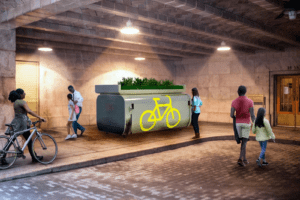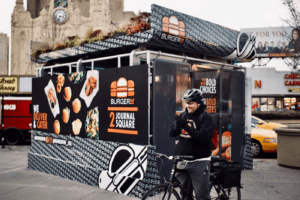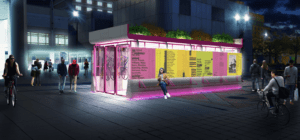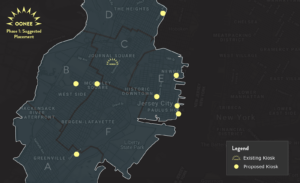by: Ben Listman

This October, Metro-North Railroad announced a pilot for secure bike parking at Grand Central with Oonee. Oonee is a Brooklyn-based company that implements and operates secure bike parking structures. Oonee has grown relevant in New York City because of the increasingly evident need for a secure bike parking network, particularly in the wake of a ridership and bike theft increase during the COVID-19 pandemic. Oonee also recently announced a partnership with Jersey City to install the country’s first municipal secure bike parking system. Looking at the state of secure bike parking in New York, and examining Oonee and Jersey City’s agreement can help paint a picture of an expanded partnership between Oonee and the MTA.
Cycling has increased in popularity as a way to get around New York City, particularly during the pandemic. However, the city lacks the secure bike parking needed for such an increase in volume. Bike theft is pervasive in the city, with about one quarter of households experiencing bike theft. Theft increased during the pandemic by twenty seven percent; as close to 4,500 bikes were reported stolen between March and September of 2020. The same time period from 2019 shows about 3,500 reported bike thefts. Concern around bike theft is central to bike commuting patterns, and has appeared in New York City studies going back almost fifteen years. A city survey published in 2007 shows a lack of secure bike parking as a serious impediment to willingness to use bikes for transportation. This issue disproportionately affects immigrants, low income communities and communities of color, who, according to a 2013 report, are more likely to travel by bike and more likely to forgo riding in the absence of secure bike parking. Secure bike parking around the city could help to increase ridership and make the city safer, more sustainable, and more liveable. Oonee began implementing solutions to this problem with the launch of its first location in Lower Manhattan in October of 2018.
Oonee’s goal is to create networks of free, easy to use, secure parking facilities for bikes and scooters. Their parking structure models range from large pods with room for at least twenty bikes to smaller pods the size of a parking space with room for ten bikes. Key cards or an app unlock the pods, and there are security cameras inside larger pods. The larger pods can also include placemaking features like benches or plants on the outside. Oonee’s basic business model is to lease space to install a pod, and generate revenue by charging advertisers to use the space available on the outside of the pod.

Oonee’s first location shuttered in 2019 because they were unable to generate revenue due to inhibitive DOT guidelines. They went on to partner with the Port Authority and a Brooklyn landowner, siting pods at Journal Square in Jersey City, and Atlantic Terminal respectively. More recently, Oonee has expanded their operation and created new pod designs. They have partnered with developers in Brooklyn and Queens to create publicly accessible parking spaces inside new buildings. They are also adding three new locations on Port Authority property in New York and New Jersey. Most notably, they will begin implementation of a secure bike parking network in Jersey City with thirty locations. Oonee also announced a partnership with Brightline, a Florida rail company, and have formed exploratory partnerships with Los Angeles, Miami, Philadelphia, and Detroit. Oonee and Metro-North Railroad’s partnership is the most recently announced pilot, and will be installed outside Grand Central on 43rd Street and Vanderbilt Avenue.

Oonee approached the MTA to request the use of their space for the Grand Central pilot, and was granted a year-long license. The pilot agreement is simple and brief, leaving few details to analyze regarding cost, time frame, and other specifics. Oonee’s recent contract to develop Jersey City’s secure bike parking network acts as an example for what an agreement could look like with the MTA. Jersey City signed a five year contract with Oonee for thirty parking locations. The first seven locations will be installed in the first phase of the project, which will take around three months. Oonee’s proposal was evaluated based on a) experience, b) commitment to diversity, c) technical criteria including planning, maintenance, and service provision, and d) management criteria including financing, and implementation schedule. The contract costs the city nothing, and Oonee will pay the city five percent on all its advertising revenue after earning $2 million in initial revenue. In addition to avoiding capital investment and operating costs, the city will likely see indirect benefits in the form of increased ridership at transit centers, increased patronage at local businesses, and improved overall livability.

Proposed Jersey City Phase One Locations
To help guide the development and expansion of their bike parking system, Oonee will create an advisory council made up of local community members. Advisory councils are a component they plan to include in all of their RFP responses and contracts. Their proposal also contains references from the Journal Square Restoration Corporation, Green City Solutions, Electric Avenue, Bike JC, and a number of Oonee users from Jersey City. These references show that Oonee has worked with the local business improvement district and bike advocacy groups, professionals knowledgeable in the field that support this project, and even locals that are willing to support them. Jersey City’s population is growing, and it is becoming increasingly popular with individuals and families wanting to live near New York City. Creating a liveable, bike friendly streetscape will go a long way in attracting new residents. Jersey City is not as dense as NYC, and has more open space to site pods which makes it a great proving ground for a truly secure bike parking network.
A partnership with the MTA to expand secure parking in NYC might be the best option when it comes to scarcity of open real estate on the street level. Oonee’s Atlantic Terminal location occupies a uniquely spacious sidewalk corner, but most sidewalks in New York City have nowhere near that amount of room. Many larger subway stations like Times Square and Atlantic Terminal have enough space inside to include pods for bike parking, but bringing bikes down into subway stations would still prove difficult. However, space does exist around larger commuter stations connected to subways like Jamaica Station in Queens. The MTA may also end up collaborating with the New York City DOT to help them find space near to subway entrances. If they choose not to work with a private firm, the MTA also has the option to implement its own secure bike parking like the The Massachusetts Bay Transit Authority or Transport for London. However, creating and administering its own secure bike parking would be cost prohibitive for the MTA. Despite receiving nearly $11 billion from Biden’s infrastructure bill, the MTA still has a deficit it needs to address. Oonee has come to the MTA with a model that works, would cost them nothing, earn them revenue, and likely encourage ridership. Partnering with a company like Oonee that takes responsibility for operations and costs is what the MTA needs now. It would help to increase ridership without eating into existing budgetary priorities.
Beginning with Grand Central, the pilot could conceivably expand to other high-traffic commuter train stations inside and outside the city. If the pilot is also adopted by New York City Transit (NYCT), the organization underneath the MTA responsible for subways and buses in the city, they could begin with high-traffic subway stations that generally have more room like Times Square, Grand Central, and 34 St-Herald Sq. The revenue sharing arrangement would likely be different than what Oonee has with Jersey City because Oonee would be using land owned by the MTA, as opposed to Jersey City helping Oonee work with local landowners. The MTA also already has advertising space and partnerships in the subways and on train platforms. OUTFRONT, the agency that handles the MTA’s advertising, would likely be able to integrate Oonee’s advertising space into its existing program. The MTA will likely demand a larger piece of revenue. Still, this partnership begins with Metro-North, and NYCT must choose to adopt Oonee as well.
Adoption by NYCT might not be far off, though. If the Metro-North pilot is successful, Oonee would appear a logical partner for NYCT. Oonee also has strong local support in New York City, and this could help push NYCT to choose Oonee. Chief among Oonee’s supporters is the city’s incoming Mayor, Eric Adams. Adams made an appearance at Oonee’s unveiling of its Oonee Mini this November, speaking on the significance of secure bike parking in encouraging ridership, particularly in addressing transit equity. Oonee’s research shows that thirty percent of their users make below $50,000 a year, and more than haf identify as non-white. Given cycling’s rise in popularity during the pandemic, it became a central topic during the mayoral race, with many candidates supporting improvements to the city’s cycling network. Adams is a long-time supporter of Oonee, having also made an appearance at the unveiling of their Atlantic Terminal pod in 2019. Adams’ support for secure bike parking dovetails with his campaign’s interest in equitable transit systems. Oonee’s November unveiling also saw representatives from numerous local organizations, including those from Transportation Alternatives, StreetsPAC, Los Deliveristas Unidos, and Good Co. Bike Club. These organizations push for safe streets for residents and workers, represent food delivery workers, and connect minority communities to cycling. This political and community support puts Oonee in a position not only to win a contract with the MTA, but also to work with communities to create an effective network of bike parking infrastructure connecting New Yorkers to transit.
Having grown in popularity over the last few years, and now having gained mainstream acknowledgement from city politicians – the incoming Mayor no less – cycling infrastructure is bound to grow and improve in New York City. With the potential benefits of helping to increase ridership at transit centers, Oonee is well positioned to offer its services to the MTA, who desperately needs to increase ridership on their commuter trains, subways, and buses. Partnering with the MTA would give Oonee access to real estate all over the city, and with a variety of pod designs they could find ways to outfit most stations with a bike parking system. The MTA will not only be looking to learn from Metro-North’s pilot with Oonee this coming year, but will also be looking to Jersey City as an example of Oonee’s potential.